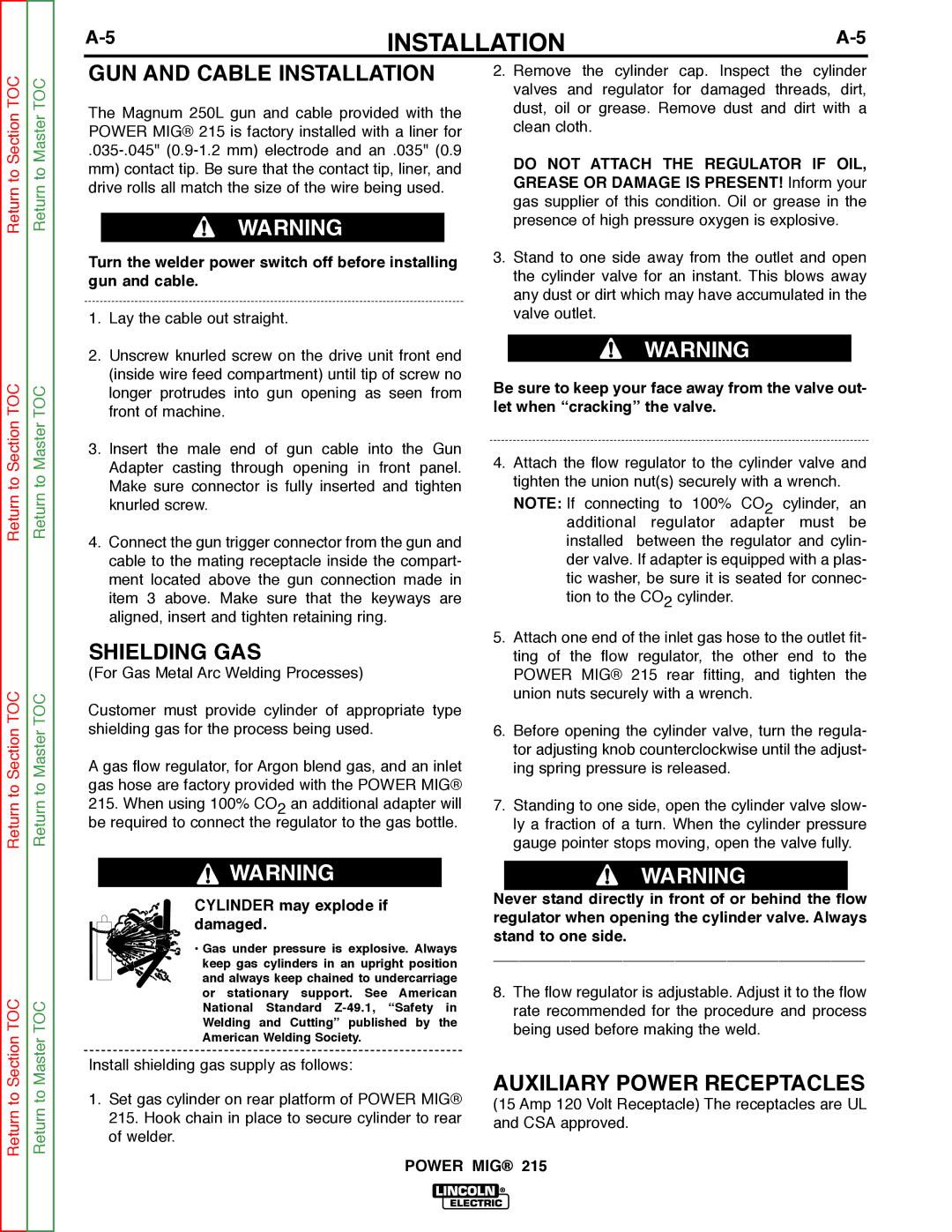
INSTALLATION |
Return to Master TOC
GUN AND CABLE INSTALLATION
The Magnum 250L gun and cable provided with the POWER MIG® 215 is factory installed with a liner for
mm)contact tip. Be sure that the contact tip, liner, and drive rolls all match the size of the wire being used.
![]() WARNING
WARNING
Turn the welder power switch off before installing gun and cable.
1. Lay the cable out straight.
2.Remove the cylinder cap. Inspect the cylinder valves and regulator for damaged threads, dirt, dust, oil or grease. Remove dust and dirt with a clean cloth.
DO NOT ATTACH THE REGULATOR IF OIL, GREASE OR DAMAGE IS PRESENT! Inform your gas supplier of this condition. Oil or grease in the presence of high pressure oxygen is explosive.
3.Stand to one side away from the outlet and open the cylinder valve for an instant. This blows away any dust or dirt which may have accumulated in the valve outlet.
Return to Section TOC
Return to Section TOC
Return to Section TOC
Return to Master TOC
Return to Master TOC
2.Unscrew knurled screw on the drive unit front end (inside wire feed compartment) until tip of screw no longer protrudes into gun opening as seen from front of machine.
3.Insert the male end of gun cable into the Gun Adapter casting through opening in front panel. Make sure connector is fully inserted and tighten knurled screw.
4.Connect the gun trigger connector from the gun and cable to the mating receptacle inside the compart- ment located above the gun connection made in item 3 above. Make sure that the keyways are aligned, insert and tighten retaining ring.
SHIELDING GAS
(For Gas Metal Arc Welding Processes)
Customer must provide cylinder of appropriate type shielding gas for the process being used.
A gas flow regulator, for Argon blend gas, and an inlet gas hose are factory provided with the POWER MIG®
215.When using 100% CO2 an additional adapter will be required to connect the regulator to the gas bottle.
![]() WARNING
WARNING
Be sure to keep your face away from the valve out- let when “cracking” the valve.
4.Attach the flow regulator to the cylinder valve and tighten the union nut(s) securely with a wrench.
NOTE: If connecting to 100% CO2 cylinder, an additional regulator adapter must be installed between the regulator and cylin- der valve. If adapter is equipped with a plas- tic washer, be sure it is seated for connec- tion to the CO2 cylinder.
5.Attach one end of the inlet gas hose to the outlet fit- ting of the flow regulator, the other end to the POWER MIG® 215 rear fitting, and tighten the union nuts securely with a wrench.
6.Before opening the cylinder valve, turn the regula- tor adjusting knob counterclockwise until the adjust- ing spring pressure is released.
7.Standing to one side, open the cylinder valve slow- ly a fraction of a turn. When the cylinder pressure gauge pointer stops moving, open the valve fully.
Return to Section TOC
Return to Master TOC
![]() WARNING
WARNING
CYLINDER may explode if damaged.
• Gas under pressure is explosive. Always keep gas cylinders in an upright position and always keep chained to undercarriage or stationary support. See American National Standard
Install shielding gas supply as follows:
1.Set gas cylinder on rear platform of POWER MIG® 215. Hook chain in place to secure cylinder to rear of welder.
![]() WARNING
WARNING
Never stand directly in front of or behind the flow regulator when opening the cylinder valve. Always stand to one side.
___________________________________________
8.The flow regulator is adjustable. Adjust it to the flow rate recommended for the procedure and process being used before making the weld.
AUXILIARY POWER RECEPTACLES
(15 Amp 120 Volt Receptacle) The receptacles are UL and CSA approved.
POWER MIG® 215
